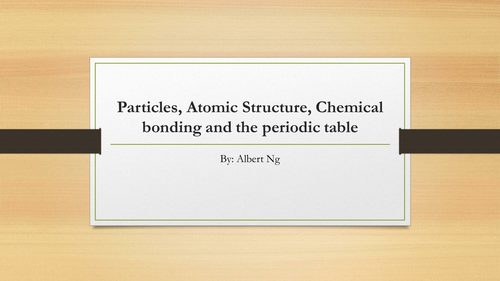
This PowerPoint slide is meant for students taking IGCSE Combined science or IGCSE Chemistry (Core) paper. Tips and formulated questions are included to enhance students' understanding.
Content covered in this slides
-Understand the terms of atom, molecules, element, compound and mixture.
-Describe the differences between atoms, elements, compounds and mixtures.
-Demonstrate the understanding of the exothermic and endothermic changes relate to the transformation of chemical energy to heat and vice versa.
-Describe the structure of an atom
-State the relative charges and approximate relative masses of protons, neutrons and electrons.
-Define proton number and nucleon number.
-Use proton number and the simple structure of atoms to explain the basis of the periodic table.
-Understand the electronic structures and valency electron.
-Describe the formation of ions by electron loss or gain.
-Describe the formation of ionic bonds between elements from group 1 and VII.
-Explain the formation of ionic bonds between metallic and non-metallic elements.
-Non-metallic elements form non-ionic compound with covalent bonding.
-Draw dot and cross diagrams to represent the sharing of electron pairs to form single covalent bond.
-Understand elements arranged in periodic table according to increasing number of proton.
-Predict the properties of elements by means of groups and periods.
-Describe the change from metallic to non-metallic character across a period.
-Describe the relationship between group number, number of valency electrons and metallic/ non-metallic character.
-Writing formulae of simple compounds.
-Construct and use word equations.
-Deduce the formula of a simple compound from the relative numbers of proton present or a diagrammatic representation.
-Describe or predict the properties of group 1 elements.
-Describe the transition elements.
Content covered in this slides
-Understand the terms of atom, molecules, element, compound and mixture.
-Describe the differences between atoms, elements, compounds and mixtures.
-Demonstrate the understanding of the exothermic and endothermic changes relate to the transformation of chemical energy to heat and vice versa.
-Describe the structure of an atom
-State the relative charges and approximate relative masses of protons, neutrons and electrons.
-Define proton number and nucleon number.
-Use proton number and the simple structure of atoms to explain the basis of the periodic table.
-Understand the electronic structures and valency electron.
-Describe the formation of ions by electron loss or gain.
-Describe the formation of ionic bonds between elements from group 1 and VII.
-Explain the formation of ionic bonds between metallic and non-metallic elements.
-Non-metallic elements form non-ionic compound with covalent bonding.
-Draw dot and cross diagrams to represent the sharing of electron pairs to form single covalent bond.
-Understand elements arranged in periodic table according to increasing number of proton.
-Predict the properties of elements by means of groups and periods.
-Describe the change from metallic to non-metallic character across a period.
-Describe the relationship between group number, number of valency electrons and metallic/ non-metallic character.
-Writing formulae of simple compounds.
-Construct and use word equations.
-Deduce the formula of a simple compound from the relative numbers of proton present or a diagrammatic representation.
-Describe or predict the properties of group 1 elements.
-Describe the transition elements.
Something went wrong, please try again later.
This resource hasn't been reviewed yet
To ensure quality for our reviews, only customers who have purchased this resource can review it
Report this resourceto let us know if it violates our terms and conditions.
Our customer service team will review your report and will be in touch.
£5.00
